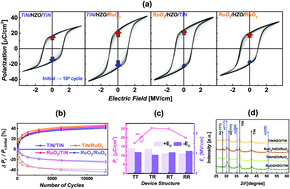Oxygen vacancy control as a strategy to achieve highly reliable hafnia ferroelectrics using oxide electrode
Abstract
Recently, hafnia ferroelectrics with two spontaneous polarization states have attracted marked attention for non-volatile, super-steep switching devices, and neuromorphic application due to their fast switching, scalability, and CMOS compatibility. However, field cycling-induced instabilities are a serious obstacle in the practical application of various low-power electronic devices that require a settled characteristic of polarization hysteresis. In this work, a large reduction in the field cycling-induced instabilities and significantly improved ferroelectric properties were observed in a Hf0.5Zr0.5O2 (HZO) thin film with a RuO2 oxide electrode. The oxide electrode can supply additional oxygen to the HZO film, consequently minimizing the oxygen vacancies at the interface which is the origin of low reliability. From the material and electrical analysis results, we verified that HZO with the RuO2 electrode has less non-ferroelectric dead layers and fewer oxygen vacancies at the interface, resulting in excellent switching properties and improved reliability. This result suggests a beneficial method to produce high-quality hafnia thin films free from interfacial defects and with stable field cycling electrical properties for actual applications.

- This article is part of the themed collection: Nanoscale 2021 Lunar New Year Collection


 Please wait while we load your content...
Please wait while we load your content...